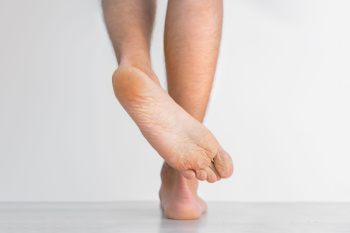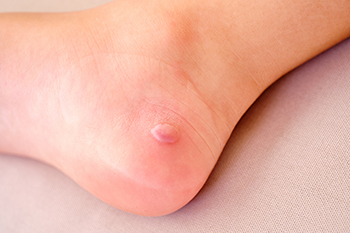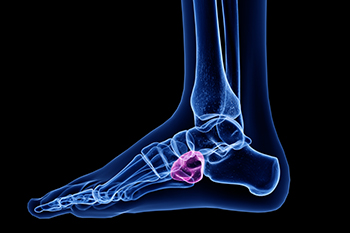Items filtered by date: February 2025
What Causes Pain in the Ball of the Foot While Running?

Pain in the ball of the foot while running can be caused by various factors, including soft tissue injuries, bone injuries, and inflammation. Soft tissue injuries, such as strain or sprain of the muscles, tendons, or ligaments, can result in pain and swelling in the ball of the foot. Bone injuries, like metatarsal fractures or stress fractures, often cause sharp, localized pain that worsens with pressure. Inflammation in the area, such as bursitis or plantar metatarsalgia, can also lead to discomfort, with symptoms including swelling, redness, and increased sensitivity. The pain may worsen with activity, especially when running or standing for extended periods. If this type of foot pain is slowing you down while running, it is suggested that you promptly consult a podiatrist who can offer effective relief and treatment solutions.
Foot Pain
Foot pain can be extremely painful and debilitating. If you have a foot pain, consult with the foot specialists from Certified Foot Care. Our doctors will assess your condition and provide you with quality foot and ankle treatment.
Causes
Foot pain is a very broad condition that could be caused by one or more ailments. The most common include:
- Bunions
- Hammertoes
- Plantar Fasciitis
- Bone Spurs
- Corns
- Tarsal Tunnel Syndrome
- Ingrown Toenails
- Arthritis (such as Gout, Rheumatoid, and Osteoarthritis)
- Flat Feet
- Injury (from stress fractures, broken toe, foot, ankle, Achilles tendon ruptures, and sprains)
- And more
Diagnosis
To figure out the cause of foot pain, podiatrists utilize several different methods. This can range from simple visual inspections and sensation tests to X-rays and MRI scans. Prior medical history, family medical history, and any recent physical traumatic events will all be taken into consideration for a proper diagnosis.
Treatment
Treatment depends upon the cause of the foot pain. Whether it is resting, staying off the foot, or having surgery; podiatrists have a number of treatment options available for foot pain.
If you have any questions, please feel free to contact our offices located in Larchmont and Brooklyn, NY . We offer the newest diagnostic and treatment technologies for all your foot care needs.
Tinea Pedis Is the Silent Invader

Tinea pedis, commonly known as athlete’s foot, is more than just an itchy nuisance. It is a fungal infection that thrives in warm, damp environments like locker rooms, public showers, and sweaty shoes. Many people do not realize they have it until symptoms like peeling skin, redness, and a burning sensation appear. The infection often starts between the toes but can spread to the soles and even the toenails, if left untreated. Ignoring tinea pedis can lead to chronic infections, cracked skin, and secondary bacterial infections. Prevention is key. Keeping feet dry, wearing breathable shoes, and avoiding walking barefoot in public spaces can reduce the risk. Mild antifungal treatments can help, but persistent or severe cases require medical attention. If symptoms worsen or do not improve, it is suggested that you see a podiatrist for stronger treatments and long-term solutions to keep your feet healthy.
Athlete’s Foot
Athlete’s foot is often an uncomfortable condition to experience. Thankfully, podiatrists specialize in treating athlete’s foot and offer the best treatment options. If you have any questions about athlete’s foot, consult with the foot specialists from Certified Foot Care. Our doctors will assess your condition and provide you with quality treatment.
What Is Athlete’s Foot?
Tinea pedis, more commonly known as athlete’s foot, is a non-serious and common fungal infection of the foot. Athlete’s foot is contagious and can be contracted by touching someone who has it or infected surfaces. The most common places contaminated by it are public showers, locker rooms, and swimming pools. Once contracted, it grows on feet that are left inside moist, dark, and warm shoes and socks.
Prevention
The most effective ways to prevent athlete’s foot include:
- Thoroughly washing and drying feet
- Avoid going barefoot in locker rooms and public showers
- Using shower shoes in public showers
- Wearing socks that allow the feet to breathe
- Changing socks and shoes frequently if you sweat a lot
Symptoms
Athlete’s foot initially occurs as a rash between the toes. However, if left undiagnosed, it can spread to the sides and bottom of the feet, toenails, and if touched by hand, the hands themselves. Symptoms include:
- Redness
- Burning
- Itching
- Scaly and peeling skin
Diagnosis and Treatment
Diagnosis is quick and easy. Skin samples will be taken and either viewed under a microscope or sent to a lab for testing. Sometimes, a podiatrist can diagnose it based on simply looking at it. Once confirmed, treatment options include oral and topical antifungal medications.
If you have any questions, please feel free to contact our offices located in Larchmont and Brooklyn, NY . We offer the newest diagnostic and treatment technologies for all your foot care needs.
Understanding Friction Blisters

Friction blisters are skin irritations that occur when repetitive rubbing or pressure causes damage to the skin's outer layers. These blisters often form on the feet, especially during physical activities like walking, running, or wearing ill-fitting shoes. Symptoms of friction blisters include redness, swelling, and a small, fluid-filled bubble on the skin. If left untreated, blisters can burst, leading to pain and a risk of infection. If you have a blister, it is important to keep the area clean and dry and avoid popping it to prevent infection. If you have persistent or painful blisters it is suggested that you seek professional care from a podiatrist who can help by assessing the severity of the blister and treat it safely. This foot doctor can advise on proper footwear, padding techniques, and how to prevent future blisters. If blisters become recurrent or infected, a podiatrist can offer more advanced treatments and care. If you are struggling with blisters, it is suggested that you make an appointment with a podiatrist for expert advice and treatment.
Blisters are prone to making everyday activities extremely uncomfortable. If your feet are hurting, contact the foot specialists of Certified Foot Care. Our doctors can provide the care you need to keep you pain-free and on your feet.
Foot Blisters
Foot blisters develop as a result of constantly wearing tight or ill-fitting footwear. This happens due to the constant rubbing from the shoe, which can often lead to pain.
What Are Foot Blisters?
A foot blister is a small fluid-filled pocket that forms on the upper-most layer of the skin. Blisters are filled with clear fluid and can lead to blood drainage or pus if the area becomes infected.
How Do Blisters Form?
Blisters on the feet are often the result of constant friction of skin and material, usually by shoe rubbing. Walking in sandals, boots, or shoes that don’t fit properly for long periods of time can result in a blister. Having consistent foot moisture and humidity can easily lead to blister formation.
Prevention & Treatment
It is important to properly care for the affected area in order to prevent infection and ease the pain. Do not lance the blister and use a Band-Aid to provide pain relief. Also, be sure to keep your feet dry and wear proper fitting shoes. If you see blood or pus in a blister, seek assistance from a podiatrist.
If you have any questions, please feel free to contact our offices located in Larchmont and Brooklyn, NY . We offer the newest diagnostic and treatment technologies for all your foot care needs.
See Your Foot Specialist Regularly If You Work On Your Feet
Cuboid Syndrome Facts

Cuboid syndrome is a condition that affects the cuboid bone, located on the outer side of the foot. This bone plays a key role in maintaining foot stability and mobility. The condition typically occurs when the cuboid bone becomes displaced or misaligned due to excessive stress or injury. The most common causes include ankle sprains, overuse, or repetitive movements that put strain on the foot. Symptoms of cuboid syndrome often include sharp pain on the outer side of the foot, difficulty bearing weight, swelling, and a feeling of instability while walking or running. In some cases, individuals may also experience tenderness when pressure is applied to the cuboid bone. To diagnose cuboid syndrome, a podiatrist will conduct a physical examination, focusing on foot movement of the affected area. X-rays or other imaging tests may be used to rule out fractures or other potential injuries. If you have pain on the outside of your foot, it is suggested that you contact a podiatrist who can accurately diagnose and treat cuboid syndrome.
Cuboid syndrome, also known as cuboid subluxation, occurs when the joints and ligaments near the cuboid bone in the foot become torn. If you have cuboid syndrome, consult with the foot specialists from Certified Foot Care. Our doctors will assess your condition and provide you with quality foot and ankle treatment.
Cuboid syndrome is a common cause of lateral foot pain, which is pain on the outside of the foot. The condition may happen suddenly due to an ankle sprain, or it may develop slowly overtime from repetitive tension through the bone and surrounding structures.
Causes
The most common causes of cuboid syndrome include:
- Injury – The most common cause of this ailment is an ankle sprain.
- Repetitive Strain – Tension placed through the peroneus longus muscle from repetitive activities such as jumping and running may cause excessive traction on the bone causing it to sublux.
- Altered Foot Biomechanics – Most people suffering from cuboid subluxation have flat feet.
Symptoms
A common symptom of cuboid syndrome is pain along the outside of the foot which can be felt in the ankle and toes. This pain may create walking difficulties and may cause those with the condition to walk with a limp.
Diagnosis
Diagnosis of cuboid syndrome is often difficult, and it is often misdiagnosed. X-rays, MRIs and CT scans often fail to properly show the cuboid subluxation. Although there isn’t a specific test used to diagnose cuboid syndrome, your podiatrist will usually check if pain is felt while pressing firmly on the cuboid bone of your foot.
Treatment
Just as the range of causes varies widely, so do treatments. Some more common treatments are ice therapy, rest, exercise, taping, and orthotics.
If you have any questions, please feel free to contact our offices located in Larchmont and Brooklyn, NY . We offer the newest diagnostic and treatment technologies for all your foot care needs.

